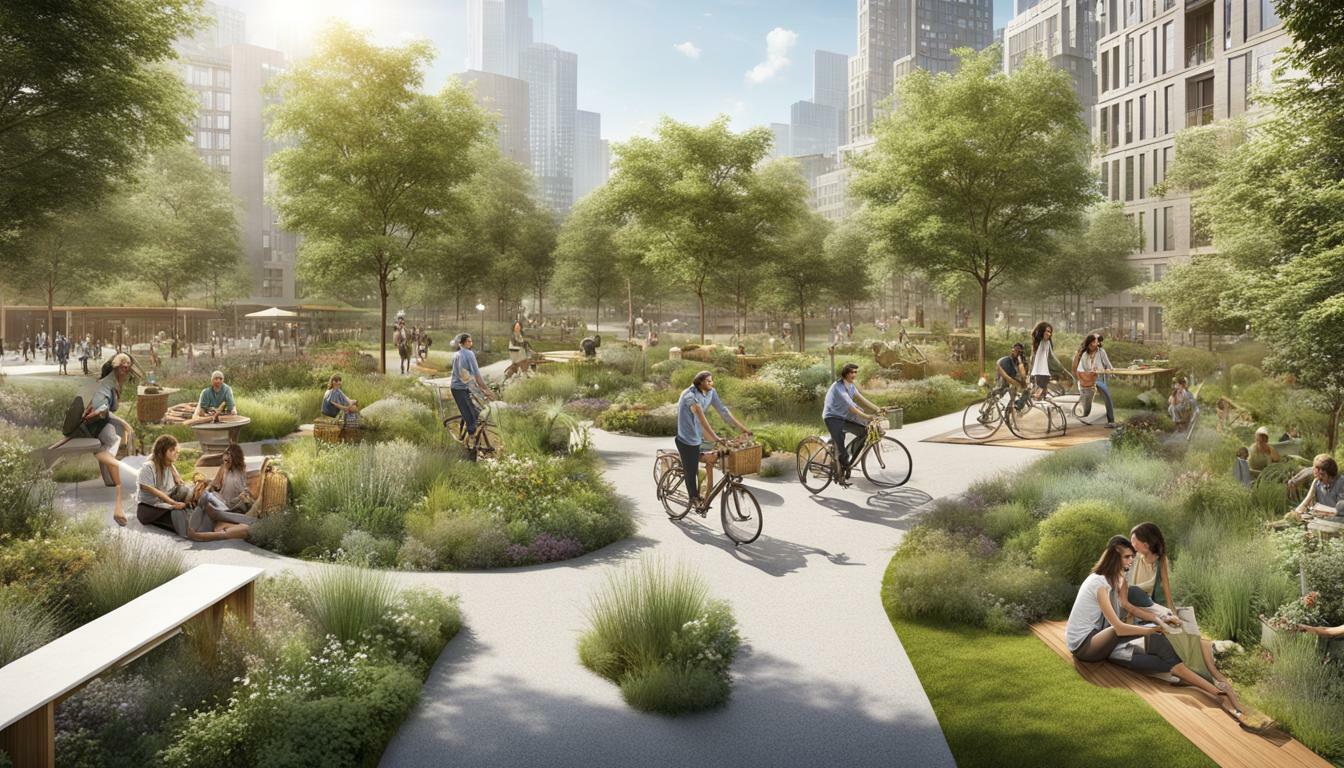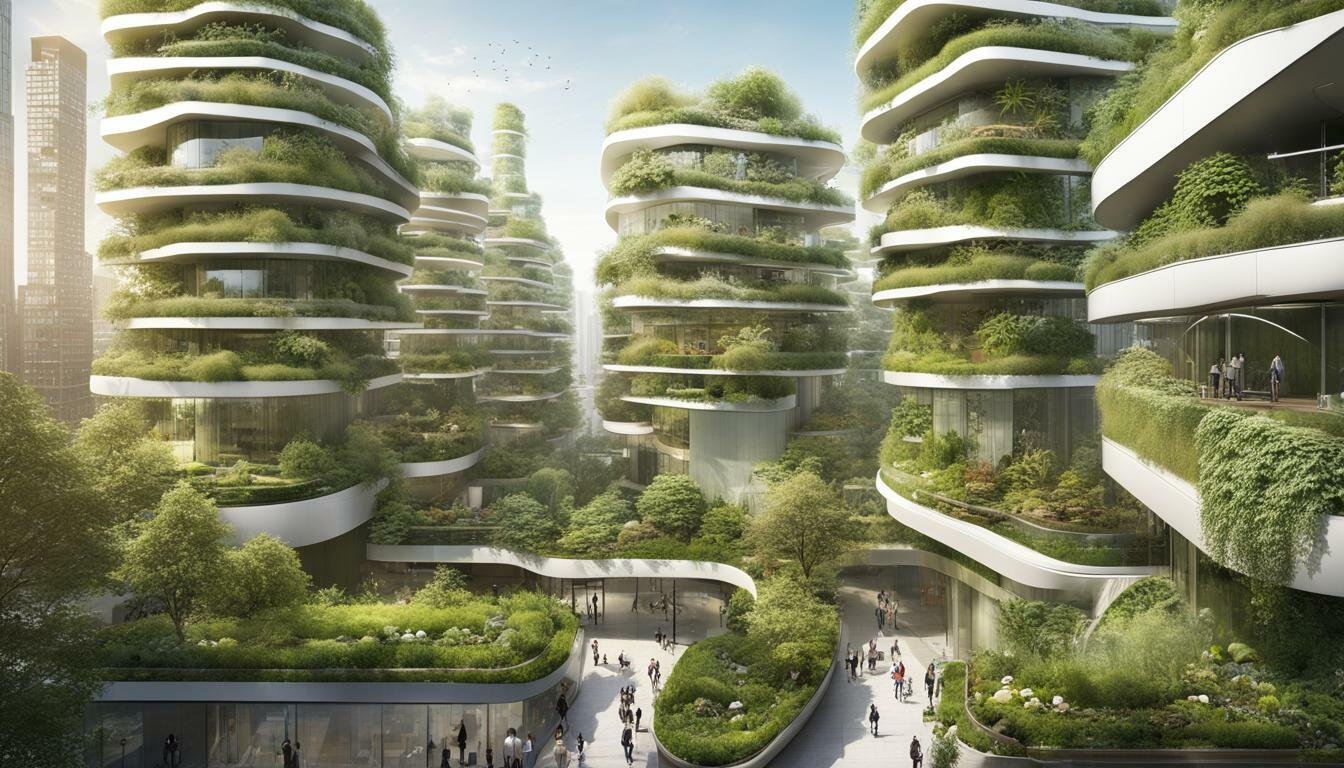Sustainable Urban Futures: How Post-Growth Cities are Leading the Way
Welcome to our exploration of the exciting new concept of post-growth cities and their significance in the context of sustainable urban futures. In this article, we will delve into the importance of sustainable development, green urban planning, and sustainable urbanization in creating environmentally friendly cities. We will also discuss the rise of post-growth cities and the factors driving this trend, as well as the innovative approaches these cities are taking towards building sustainable infrastructure, revolutionizing transportation, embracing urban agriculture, and engaging citizens in decision-making processes.
As we face the challenges of climate change and rapid urbanization, post-growth cities are leading the way in creating resilient, regenerative, and sustainable urban environments. By prioritizing eco-friendly infrastructure, promoting green spaces, and embracing citizen participation, post-growth cities are demonstrating how we can build a better future for ourselves and the planet.
Key Takeaways:
- Post-growth cities are leading the way towards sustainable urban futures.
- Sustainable development, green urban planning, and sustainable urbanization are crucial for creating environmentally friendly cities.
The Rise of Post-Growth Cities
Post-growth cities are increasingly becoming popular as an innovative model for sustainable urban futures. These cities are designed with a focus on urban resilience, circular economy, and regenerative design principles. They prioritize the needs of citizens, the environment, and the economy, ensuring that each stakeholder benefits in the long run.
One of the key factors driving the rise of post-growth cities is the need for urban resilience. Climate change has led to an increase in natural disasters, urbanization, and population growth, resulting in a greater need for cities to be adaptable and resilient. As such, post-growth cities are built to withstand environmental shocks and stresses.
The adoption of circular economy principles is also a significant driver in the rise of post-growth cities. These principles seek to reduce waste, maximize resource use, and promote sustainable consumption and production. Post-growth cities embrace a circular economy by implementing sustainable infrastructure, embracing green spaces, and promoting sustainable transportation options.
Regenerative design practices, which focus on creating systems that are self-regulating and sustainable, are also central to post-growth city planning. These cities prioritize the regeneration of natural systems, the promotion of biodiversity, and the design of buildings and infrastructure that have a positive impact on the environment.
Some examples of post-growth cities leading the way include Amsterdam, which has implemented a circular economy strategy that encompasses energy, water, and waste management, and San Francisco, which has set a goal of zero waste by 2020. Barcelona is also working towards becoming a self-sufficient city through the promotion of urban agriculture and a focus on low-carbon transportation.

Image Source: https://seowriting.ai/32_6.png
Building Sustainable Infrastructure
Post-growth cities recognize the need for eco-friendly infrastructure to ensure a sustainable urban future. One way cities are achieving this is through the promotion of green spaces. Green spaces are not only aesthetically pleasing, but they also provide numerous benefits for urban areas.
Research has shown that green spaces can improve air quality, reduce the urban heat island effect, and provide habitats for urban wildlife. Additionally, these spaces can improve the overall well-being of citizens by providing places to exercise, relax, and connect with nature. Post-growth cities are prioritizing the development of green spaces by incorporating them into urban planning and design.
Urban planners are also exploring new ways to create eco-friendly infrastructure. This includes the implementation of green roofs, which are covered in vegetation and help to regulate building temperatures while also improving air quality. Furthermore, cities are investing in sustainable drainage systems to manage stormwater runoff. These systems mimic natural water cycles and help to reduce the risk of floods while also providing habitats for wildlife.

Overall, building sustainable infrastructure is essential for the long-term health and resilience of post-growth cities. By prioritizing eco-friendly infrastructure and green spaces, these cities are creating more liveable urban environments for their citizens while also protecting the planet.
Revolutionizing Transportation
Transportation is one of the biggest contributors to carbon emissions in urban areas. Post-growth cities are taking innovative steps towards reducing their carbon footprint by introducing low-carbon transportation options.
Electric vehicles are becoming increasingly popular in urban areas, and many post-growth cities are incentivizing their use by providing charging infrastructure and promoting their benefits. In addition, cycling infrastructure is being expanded and improved, making it easier and safer for citizens to use cycling as a form of transportation.
Efficient public transportation networks are also a priority in post-growth cities. These networks, such as high-speed trains, trams, and buses running on low-emission fuels, reduce congestion on the roads and improve air quality.
By prioritizing low-carbon transportation options, post-growth cities are not only reducing their carbon footprint but also improving the quality of life for their citizens with cleaner air and fewer traffic jams.

Embracing Urban Agriculture
Post-growth cities are turning to urban agriculture as a means of promoting local food production, enhancing community resilience, and improving food security. With the world’s population projected to reach 9.7 billion by 2050, it has become imperative to find innovative ways to feed the growing urban population sustainably. Urban agriculture presents a viable solution to this challenge.
One innovative approach to urban farming is vertical agriculture. This involves growing crops in vertically stacked layers, using minimal space and resources. Vertical farms can produce up to 100 times more food per square foot than traditional farming methods and require 70% less water. Cities such as Singapore and Hong Kong have embraced this technology, with vertical farms sprouting up in their urban landscapes.

Another approach is the integration of food-growing spaces within urban landscapes. Cities such as Detroit and Chicago have transformed vacant lots and abandoned buildings into community gardens, providing fresh produce for local residents and fostering a sense of community. This approach not only produces food but also enhances the aesthetic appeal of the city.
Urban agriculture also provides an opportunity for citizens to engage in food production and to learn about sustainable living practices. Cities such as Berlin have implemented urban farming education programs, providing citizens with the skills and knowledge to grow their food sustainably, promoting citizen participation and engagement in creating sustainable urban futures.
Citizen Engagement and Participation
Citizen engagement and participation are crucial for achieving sustainable urbanization in post-growth cities. When citizens are actively involved in decision-making processes, they become more invested in the outcome and are more likely to support and adopt sustainable initiatives.
Examples of successful citizen engagement in post-growth cities include Amsterdam’s “City-zen” project, which involved citizens in the implementation of sustainable energy initiatives, and Barcelona’s “Superblocks” project, which engaged local communities in the transformation of their neighbourhoods into car-free zones.
Citizen participation can take various forms, including public consultations, participatory budgeting, and co-creation processes. By involving citizens in the planning and development of their cities, post-growth cities can ensure that initiatives are tailored to the specific needs of their communities.
Furthermore, citizen engagement and participation can help build trust between local authorities and citizens, creating a sense of ownership over sustainable initiatives and promoting long-term support and adoption.
Examples of Citizen Participation in Post-Growth Cities
In Vancouver, the city’s Greenest City Action Plan involved extensive public consultations, with over 15,000 residents contributing ideas and feedback on the plan’s development. As a result, the plan includes initiatives such as expanding green space, increasing cycling infrastructure, and reducing waste in local businesses.
The city of Freiburg in Germany has implemented participatory budgeting, empowering citizens to decide on the allocation of public funds for sustainable initiatives such as renewable energy and energy-efficient buildings. This approach has led to high levels of citizen engagement, with over 20% of the population participating in the budgeting process.

“Involving citizens in the development of sustainable initiatives can lead to better outcomes, increased support, and stronger communities.”
Overcoming Challenges and Barriers
Despite the many benefits of post-growth cities, there are several challenges and barriers that they must overcome in order to achieve sustainable urbanization. Political resistance is often a major obstacle, as many politicians and policymakers are hesitant to implement new policies that may be unpopular with their constituents.
Lack of funding is another significant barrier, as many post-growth initiatives require substantial investments in new infrastructure and technologies. This can be particularly challenging for cities in developing countries, where resources are often limited.
Finally, the need for policy and regulatory frameworks that support sustainable development is crucial. Without clear guidance from government officials and other stakeholders, it can be difficult for post-growth cities to implement new initiatives and make real progress towards sustainable urbanization.
Despite these challenges, many post-growth cities are making significant strides in promoting sustainable development and creating environmentally friendly urban spaces. By working collaboratively with citizens, policymakers, and other key stakeholders, these cities are leading the way towards a more sustainable and resilient urban future.

Conclusion
In conclusion, post-growth cities are leading the way towards sustainable urban futures through the adoption of green urban planning, sustainable urbanization, and citizen engagement. These cities prioritize the development of eco-friendly infrastructure, low-carbon transportation, and urban agriculture to promote local food production and improve community resilience. The integration of circular economy principles and regenerative design practices also plays a vital role in making cities more sustainable.
Challenges and Barriers
However, post-growth cities also face challenges and barriers, such as political resistance and a lack of funding. Policy and regulatory frameworks must support sustainable development to ensure that these cities can continue their journey towards a more environmentally friendly future.
Despite these challenges, the rise of post-growth cities provides hope for a more sustainable future. Citizen engagement and participation are essential in shaping the urban landscape, and initiatives that involve the community in decision-making processes have shown positive results in promoting sustainable urbanization.
Overall, post-growth cities serve as a model for the cities of tomorrow. Their efforts in promoting sustainable development, green urban planning, and citizen engagement have led the way towards a more eco-friendly future. It is crucial that we continue to support and learn from these cities as we strive for a more sustainable world.
FAQ
Q: What are post-growth cities?
A: Post-growth cities are urban areas that prioritize sustainable development, green urban planning, and sustainable urbanization in order to create environmentally friendly cities.
Q: What factors are driving the rise of post-growth cities?
A: The rise of post-growth cities is driven by the need for urban resilience, the adoption of circular economy principles, and the integration of regenerative design practices.
Q: How do post-growth cities prioritize sustainable infrastructure?
A: Post-growth cities prioritize the development of eco-friendly infrastructure, including the promotion of green spaces, to improve air quality, preserve biodiversity, and enhance overall citizen well-being.
Q: How are transportation systems being revolutionized in post-growth cities?
A: Post-growth cities are revolutionizing transportation systems by implementing low-carbon options such as electric vehicles, cycling infrastructure, and efficient public transportation networks.
Q: How are post-growth cities embracing urban agriculture?
A: Post-growth cities are embracing urban agriculture to promote local food production, improve food security, and enhance community resilience. This includes innovative approaches to urban farming and integrating food-growing spaces within urban landscapes.
Q: Why is citizen engagement and participation important in post-growth cities?
A: Citizen engagement and participation are crucial in the development and implementation of post-growth initiatives. Involving citizens in decision-making processes has a positive impact on sustainable urban development.
Q: What challenges and barriers do post-growth cities face?
A: Post-growth cities face challenges such as political resistance, lack of funding, and the need for supportive policy and regulatory frameworks to overcome barriers to sustainable urbanization.







